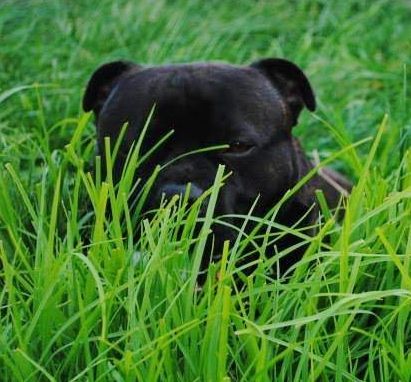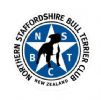Breed Health

The Staffordshire Bull Terrier, whilst a robust and generally healthy breed, can suffer from harmful and detrimental genetic diseases. Responsible breeders, with the support of DogsNZ and other breeders, are attempting to selectively breed out these hereditary afflictions.
When purchasing a Staffordshire Bull Terrier from registered breeders (unfortunately not all breeders are registered with the ANKC, and generally refrain from health testing breeding stock) do not be afraid to ask the breeder about their stock, their breeding practices, nor be afraid to ask to see health certificates.
At our recent AGM held on 26 May 2019 we agreed as a club to look at LRL (Littr Registration Limitation). The Labrador clubs have undertaken this and it appears to be successful in weeding out unhealthy or genetic problems within that breed. We feel that it may benefit our Staffords - check out the link www.dogsnz,.org.nz/labrador-retriever-litters for more information. We will consult the other two Stafford Clubs in NZ and report back at a later date.
L2-HGA
L-2-HGA (L-2-hydroxyglutaric aciduria) in Staffordshire Bull Terriers is a neurometabolic disorder characterized by elevated levels of L-2-hydroxyglutaric acid in urine, plasma and cerebrospinal fluid.
L-2-HGA affects the central nervous system, with clinical signs usually apparent between 6 months and one year (although they can appear later). Symptoms include epileptic seizures, "wobbly" gait, tremors, muscle stiffness as a result of exercise or excitement and altered behaviour.
The mutation, or change to the structure of the gene, probably occurred spontaneously in a single dog but once in the population has been inherited from generation to generation like any other gene. The disorder shows an autosomal recessive mode of inheritance: two copies of the defective gene (one inherited from each parent) have to be present for a dog to be affected by the disease.
Individuals with one copy of the defective gene and one copy of the normal gene - called carriers - show no symptoms but can pass the defective gene onto their offspring. When two apparently healthy carriers are crossed, 25% (on average) of the offspring will be affected by the disease, 25% will be clear and the remaining 50% will themselves be carriers.
The mutation responsible for the disease has recently been identified at the Animal Health Trust. Using the information from this research, we have developed a DNA test for the disease. This test not only diagnoses dogs affected with this disease but can also detect those dogs which are carriers, displaying no symptoms of the disease but able to produce affected pups.
Carriers could not be detected by the tests previously available which involved either a blood or urine test detecting elevated levels of L-2-hydroxyglutarate or magnetic resonance imaging. Under most circumstances, there will be a much greater number of carriers than affected animals in a population. It is important to eliminate such carriers from a breeding population since they represent a hidden reservoir of the disease that can produce affected dogs at any time.
The test is available now and information on submitting samples is given below.
Breeders will be sent results identifying their dog as belonging to one of three categories:
CLEAR: the dog has 2 copies of the normal gene and will neither develop L-2-HGA, nor pass a copy of the L-2-HGA gene to any of its offspring.
CARRIER: the dog has one copy of the normal gene and one copy of the mutant gene that causes L-2-HGA. It will not develop L-2-HGA but will pass on the L-2-HGA gene to 50% (on average) of its offspring.
AFFECTED: the dog has two copies of the L-2-HGA mutation and is affected with L-2-HGA. It will develop L-2-HGA at some stage during its lifetime, assuming it lives to an appropriate age.
Carriers can still be bred to clear dogs. On average, 50% of such a litter will be clear and 50% carriers; there can be no affecteds produced from such a mating. Pups which will be used for breeding can themselves be DNA tested to determine whether they are clear or carrier.
Courtesy AHT
Hereditary Cataracts (also called Juvenile Cataracts)
Hereditary Cataract in Staffordshire Bull Terriers has been recognized as an inherited condition since the late 1970’s. Affected dogs develop cataracts in both eyes at an early age. The condition is not congenital, so the lenses are normal at birth but cataracts appear at a few weeks to months in age, progressing to total cataract (and resulting blindness) by 2 to 3 years of age.
The mutation, or change to the structure of the gene, probably occurred spontaneously in a single dog but once in the population has been inherited from generation to generation like any other gene. The disorder shows an autosomal recessive mode of inheritance: two copies of the defective gene (one inherited from each parent) have to be present for a dog to be affected by the disease.
Individuals with one copy of the defective gene and one copy of the normal gene - called carriers - show no symptoms but can pass the defective gene onto their offspring. When two apparently healthy carriers are crossed, 25% (on average) of the offspring will be affected by the disease, 25% will be clear and the remaining 50% will themselves be carriers.
The mutation responsible for the disease has recently been identified at the Animal Health Trust. Using the information from this research, we have developed a DNA test for the disease. This test not only diagnoses dogs affected with the disease but can also detect those dogs which are carriers, displaying no symptoms of the disease but able to produce affected pups.
Under most circumstances, there will be a much greater number of carriers than affected animals in a population. It is important to eliminate such carriers from a breeding population since they represent a hidden reservoir of the disease that can produce affected dogs at any time.
The test is available now and information on submitting samples is given below.
Breeders will be sent results identifying their dog as belonging to one of three categories:
CLEAR: the dog has 2 copies of the normal gene and will neither develop Hereditary Cataract, nor pass a copy of the Hereditary Cataract gene to any of its offspring.
CARRIER: the dog has one copy of the normal gene and one copy of the mutant gene that causes Hereditary Cataract. It will not develop Hereditary Cataract but will pass on the Hereditary Cataract gene to 50% (on average) of its offspring.
AFFECTED: the dog has two copies of the Hereditary Cataract mutation and is affected with Hereditary Cataract. It will develop Hereditary Cataract at some stage during its lifetime, assuming it lives to an appropriate age.
Carriers can still be bred to clear dogs. On average, 50% of such a litter will be clear and 50% carriers; there can be no affecteds produced from such a mating. Pups which will be used for breeding can themselves be DNA tested to determine whether they are clear or carrier. Courtesy AHT
Distichiasis
Sometimes the condition is referred to as a double row of eyelashes, for extra hairs arise from the edge of the eyelid to rub against the corneal surface. The effects are variable and mild irritation to corneal ulceration will be seen. Treatment is extremely difficult and invariably involves surgery to remove the hair roots permanently. Plucking out the offending hairs is useful, but requires the maximum cooperation of the patient!
Of course it is followed by hair regrowth, and many surgical techniques have been invented to remove the roots. Even then success is difficult to achieve, and the dog may have to suffer this condition throughout its life. It is the most common eye defect found in the Stafford in South Africa.
Entropian
Primarily an inherited condition. It is due to an excess of eyelid tissue, or a small eye, or both, the result being that a varying amount of hair-covered eyelid can turn in to rub directly against the cornea or conjunctiva, or both.
It is usually extremely painful, and the damage caused to the cornea can render the eye blind. Most dogs are affected by six months of age and in some the signs of the problem (excessive blinking and a wet face) may be seen within the first month of life.
Occasionally the condition is self-correcting as the puppy grows, but in the vast majority of affect dogs surgery is necessary to turn the eyelid away from the surface of the eye. Usually such surgery is successful, but it is much better that, as with the other inherited eyelid defects, breeders try to avoid producing this condition in their stock.
Ectropion
Primarily an inherited condition, in which the lower eyelid droops away from the eyeball to expose the third eyelid and the conjunctiva. Exposure of the delicate mucous membrane causes conjunctivitis.
Correction is possible by complicated surgery in which the eyelid is lifted and shortened. Occasionally further surgery may be necessary to change completely the shape of the eyelids.
Progressive Retinal Atrophy (PRA)
PRA is a term used to describe a number of inherited retinal degenerations involving several breeds. The group is broadly divided into two, generalized PRA and central PRA. In the former, blindness at night time (nyctalopia) is an early indication of the presence of the disease, but eventually the dog is rendered totally blind.
Cataract is a common secondary feature of the disease. In central PRA night blindness is not a feature and though vision is several affected, the dog may not become totally blind. In both groups of PRA there is degeneration of the photoreceptors, but in the generalized form this degeneration is the inherited defect, whereas in central PRA rod and cone degeneration follows an inherited defect elsewhere in the retina.
Persistent Hyperplastic Primary Vitreous (PHPV)
This is a congenital condition (present from birth) in which there is a developmental defect in the normal regression of some of the intraocular structures of the eye. PHPV can range from being very mild to severe abnormalities which may lead to blindness.
The presence of mild abnormalities are usually seen as small brown pigmented dots on the posterior lens capsule. Previously the literature indicated that this was always observed as a bilateral phenomenon but recently it has been stated that affected dogs may show unilateral involvement, although this is less common.
The present knowledge of the mode of inheritance of this disease is thought to be an autosomal irregular dominant with variable expression. Due to PHPV seldom resulting in secondary cataracts in the Stafford, those that are mildly afflicted will seldom show any form of visual impairment during the course of their lives. Even those that are more severely afflicted, may be capable of adapting by using peripheral to compensate.
Stafford breeders should therefore not assume that the problem is absent simply because they have not encountered blatant signs of visual impairment, instead discerning breeders should ensure that all their Staffords are tested through the National Eye Scheme.
Contact Details
The Northern Staffordshire Bull Terrier Club
Secretary
Sandra Smid
NSBTC PO Box 158, Meremere 2441
Email: [email protected]
